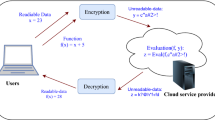Abstract
With the rapid development of cloud computing technology, cloud services are gaining wider application space. It gives users the advantage of computing power and storage space that were beyond the reach of the past. However, user privacy and data security are the main problems in the application and promotion of cloud system. How to ensure the privacy of data and ensure its availability in the process of calculating data is a major problem. Ensuring both the privacy and the usability of the data in the process of calculation remains a major challenge. As a promising tool for solving such problem, homomorphic encrytion is a hot topic in both academia and industry in recent years. The purpose of this research is to demonstrate the effectiveness of the Paillier encryption and its homomorphic properties implemented in an electronic voting system. We describe an e-voting system based on Paillier homomorphic encryption along with other cryptographic tools such as blind signatures and zero-knowledge proof. The proposed scheme guarantees the general voting system requirements such as eligibility, accuracy, simplicity, privacy, robustness and verifiability. The scheme is implemented in C++ using GMP, an arithmetic multiprecision library, and the “Paillier” library. This implementation uses the CPU to make the calculations necessary during encryption, decryption, vote validation, and tallying. Some portions of the proposed e-voting scheme such as signing the blinded ballots, checking for valid votes and counting up the votes could be made to run in parallel in order to improve the e-voting system performance. We also implement a “small” version of the voting system using CUDA and demonstrate that it is possible to use the GPU’s processing power to accelerate the speed of this e-voting system.
Access this chapter
Tax calculation will be finalised at checkout
Purchases are for personal use only
Similar content being viewed by others
Notes
- 1.
\(\sigma \) is a valid signature on \(e_i\) by the registration authority A, but \(e_i\) is never revealed to A.
- 2.
This step can be asymptotically improved from O(n) to \(O(\log n)\) by a parallel algorithm that apply multiplication operation in a pairwise fashion using a binary tree.
References
Youth vote in the united states. https://en.wikipedia.org/wiki/Youth_vote_in_the_United_States
Voters with disabilities: Observations on polling place accessibility and related federal guidance (2017). https://www.gao.gov/products/GAO-18-4
2016 November general election turnout rates (2018). http://www.electproject.org/2016g
Baudron, O., Fouque, P.A., Pointcheval, D., Stern, J., Poupard, G.: Practical multi-candidate election system. In: Proceedings of the Twentieth Annual ACM Symposium on Principles of Distributed Computing, PODC 2001, pp. 274–283. ACM (2001)
Bethencourt, J.: Paillier library. http://hms.isi.jhu.edu/acsc/libpaillier/
Boneh, D., Golle, P.: Almost entirely correct mixing with applications to voting. In: Proceedings of the 9th ACM Conference on Computer and Communications Security, CCS 2002, pp. 68–77. ACM (2002)
Chaum, D.: Blind signatures for untraceable payments. In: Advances in Cryptology: Proceedings of CRYPTO 1982, pp. 199–203. Plenum (1982)
Cramer, R., Damgård, I., Schoenmakers, B.: Proofs of partial knowledge and simplified design of witness hiding protocols. pp. 174–187, January 1994
Damgard, I.: On \(\varSigma \)-protocols (2010). http://www.daimi.au.dk/~ivan/Sigma.ps. Version 2
Dossogne, J., Lafitte, F.: Blinded additively homomorphic encryption schemes for self-tallying voting. In: Proceedings of the 6th International Conference on Security of Information and Networks, SIN 2013, pp. 173–180. ACM (2013)
Emmart, N.: A study of high performance multiple precision arithmetic. Ph.D. thesis, University of Massachusetts Amherst, March 2018
Fiat, A., Shamir, A.: How to prove yourself: practical solutions to identification and signature problems. In: Proceedings on Advances in Cryptology—CRYPTO 1986, pp. 186–194. Springer, London (1987)
Goldwasser, S., Micali, S., Rackoff, C.: The knowledge complexity of interactive proof-systems. In: Proceedings of the Seventeenth Annual ACM Symposium on Theory of Computing, STOC 1985, pp. 291–304. ACM, New York (1985)
Guillou, L.C., Quisquater, J.J.: A “paradoxical” identity-based signature scheme resulting from zero-knowledge. In: Proceedings on Advances in Cryptology, pp. 216–231. CRYPTO 1988. Springer, Berlin (1990)
Heiberg, S., Kubjas, I., Siim, J., Willemson, J.: On trade-offs of applying block chains for electronic voting bulletin boards. IACR Cryptol. ePrint Archive 2018, 685 (2018)
Juels, A., Catalano, D., Jakobsson, M.: Coercion-resistant electronic elections. In: Proceedings of the 2005 ACM Workshop on Privacy in the Electronic Society, WPES 2005, pp. 61–70. ACM (2005)
Moura, T., Gomes, A.: Blockchain voting and its effects on election transparency and voter confidence. In: Proceedings of the 18th Annual International Conference on Digital Government Research, DG.O 2017, pp. 574–575. ACM (2017)
n1analytics: n1analytics/cuda-fixnum, November 2018. https://github.com/n1analytics/cuda-fixnum
NVlabs: Nvlabs/xmp, September 2016. https://github.com/NVlabs/xmp
Paillier, P.: Public-key cryptosystems based on composite degree residuosity classes. In: Proceedings of the 17th International Conference on Theory and Application of Cryptographic Techniques, EUROCRYPT 1999, pp. 223–238. Springer (1999)
Parsovs, A.: Homomorphic tallying for the estonian internet voting system. IACR Cryptol. ePrint Archive 2016, 776 (2016)
Rivest, R.L., Shamir, A., Adleman, L.: A method for obtaining digital signatures and public-key cryptosystems. Commun. ACM 21(2), 120–126 (1978)
skystar0227: skystar0227/CUMP, October 2012. https://github.com/skystar0227/CUMP
Author information
Authors and Affiliations
Corresponding author
Editor information
Editors and Affiliations
Rights and permissions
Copyright information
© 2020 Springer Nature Switzerland AG
About this paper
Cite this paper
Zhang, M., Romero, S. (2020). Design and Implementation of an e-Voting System Based on Paillier Encryption. In: Arai, K., Kapoor, S., Bhatia, R. (eds) Advances in Information and Communication. FICC 2020. Advances in Intelligent Systems and Computing, vol 1129. Springer, Cham. https://doi.org/10.1007/978-3-030-39445-5_59
Download citation
DOI: https://doi.org/10.1007/978-3-030-39445-5_59
Published:
Publisher Name: Springer, Cham
Print ISBN: 978-3-030-39444-8
Online ISBN: 978-3-030-39445-5
eBook Packages: Intelligent Technologies and RoboticsIntelligent Technologies and Robotics (R0)




